| Healthcare Providers On This Page:
| Continuing Education (CE) Opportunities |
Online training program (CME) - Otitis Media
With support from CDC, the Children’s Hospital of Pittsburgh/University of Pittsburgh developed an online training program to improve knowledge in understanding middle ear disease and skill in visually diagnosing middle ear effusions. The program titled “ePROM: Enhancing Proficiency in Otitis Media” includes six individual courses covering pneumatic otoscopy, otitis media with effusion (OME), acute otitis media (AOM), tympanometry, acoustic reflectometry, and tympanocentesis. (exit site)
Improving Appropriate Antibiotic Prescribing for Acute Respiratory Infections courses
Improving Appropriate Antibiotic Prescribing for Acute Respiratory Infections (exit site) is a free, interactive case-based on-line learning experience that will enhance your ability to:
- Describe four consequences of the overuse of antibiotics for acute respiratory infections
- Apply the principles of appropriate antibiotic use for treatment of acute bronchitis, acute sinusitis, pharyngitis and acute otitis media
- Develop practical strategies to adopt appropriate antibiotic use within your practice.
Antimicrobial Drug Use and Resistance in Europe NEW!
The Antimicrobial Drug Use and Resistance in Europe (exit site) course is offered through the Emerging Infectious Diseases journal with CE credits provided by Medscape, LLC.
Upon completion of this activity, participants will be able to:
- Identify the classes of antimicrobial drugs most commonly used in Europe.
- Describe patterns of antimicrobial drug use across regions in Europe.
- Identify the most widely used antimicrobial drugs by country in Europe.
- List European countries that show the highest antimicrobial drug resistance proportions.
- Describe the association between antimicrobial drug use and the emergence of resistance.
|
|
Back to top
Adult treatment guidelines for upper respiratory tract infections |
Publications - Principles for Adult Appropriate Antibiotic Use
- Principles of Appropriate Antibiotic Use for Treatment of Acute Respiratory Tract Infections in Adults: Background, Specific Aims, and Methods
Gonzales R, Bartlett JG, Besser RE, Cooper RJ, Hickner JM, Hoffman JR, Sande MA. Annals of Internal Medicine. March 20, 2001;134:479-486.
The guidelines in this issue provide evidence-based recommendations for evaluation and treatment of adults with acute respiratory illnesses. This paper describes the background and specific aims of and methods used to develop these principles. The goal of the principles is to provide clinicians with practical strategies for limiting antibiotic use to the patients who are most likely to benefit from it.
Abstract | Full Text
- Principles of Appropriate Antibiotic Use for Treatment of Nonspecific Upper Respiratory Tract Infections in Adults: Background
Gonzales R, Bartlett JG, Besser RE, Hickner JM, Hoffman JR, Sande MA. Annals of Internal Medicine. March 20, 2001;134:490-494.
The goals of this paper are to provide evidence-based recommendations for when to apply the diagnosis of upper respiratory tract infection and when to consider antibiotic treatment of adults with an uncomplicated upper respiratory tract infection.
Abstract | Full Text
- Principles of Appropriate Antibiotic Use for Acute Rhinosinusitis in Adults: Background
Hickner JM, Bartlett JG, Besser RE, Gonzales R, Hoffman JR, Sande MA. Annals of Internal Medicine. March 20, 2001;134:498-505.
This paper argues for a conservative approach to use of antibiotics in patients with sinusitis-like symptoms, consistent with efforts to reduce antibiotic use for respiratory infections in ambulatory patients.
Abstract | Full Text
- Principles of Appropriate Antibiotic Use for Acute Pharyngitis in Adults: Background
Cooper RJ, Hoffman JR, Bartlett JG, Besser RE, Gonzales R, Hickner JM, Sande MA. Annals of Internal Medicine. March 20, 2001;134:509-517.
Most immunocompetent adults with sore throat have acute infectious pharyngitis. Widespread antibiotic use in such patients has been based on an effort to treat bacterial (particularly streptococcal) pharyngitis. This paper addresses the rational treatment of nongonococcal, nondiphtherial acute pharyngitis in healthy adults.
Abstract | Full Text
- Principles of Appropriate Antibiotic Use for Treatment of Uncomplicated Acute Bronchitis: Background
Gonzales R, Bartlett JG, Besser RE, Cooper RJ, Hickner JM, Hoffman JR, Sande MA. Annals of Internal Medicine. March 20, 2001;134:521-529.
Most cases of acute bronchitis occur in otherwise healthy adults, in whom this acute cough illness can be called "uncomplicated acute bronchitis." This paper discusses use of antibiotics in these patients.
Abstract | Full Text
- Diagnosis and Management of Cough: ACCP Evidence-Based Clinical Practice Guidelines
Irwin RS, Baumann MH, Bolser DC , et al: Diagnosis and management of cough: ACCP evidence-based clinical practice guidelines. Chest 1S-292S, 2006.
These practice guidelines (1) more narrowly focuses the guidelines on the diagnosis and treatment of cough, the symptom, in adult and pediatric populations, and minimizes the discussion of cough as a defense mechanism; (2) improves on the rigor of the evidence-based review and describes the methodology in a separate section; (3) updates and expands, when appropriate, all previous sections; and (4) adds new sections with topics that were not previously covered.
Cough Guidelines on the Chest website (exit site)
Back to top
| One page adult academic detailing sheets |
These sheets are useful for conducting small group or one-on-one educational sessions. They have been used by many programs around the country seeking to change clinician prescribing behavior.
 |
Adult academic detailing sheets |
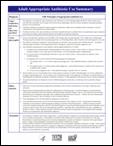
|
Adult Appropriate Antibiotic Use Summary: Physician Information Sheet (Adults)
Target Audience: Clinicians, Health Educators, Infection Control Professionals, Nurse Practitioners, Nurses, Physician Assistants, Physicians, Pharmacists
CDC recommendations for promoting prudent antibiotic use in adults.
|
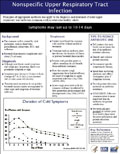
|
Nonspecific Upper Respiratory Tract Infection: Physician Information Sheet (Adults)
Target Audience: Clinicians, Health Educators, Infection Control Professionals, Nurse Practitioners, Nurses, Physician Assistants, Physicians, Pharmacists
Principles of appropriate antibiotic use apply to the diagnosis and treatment of acute upper respiratory tract infection (common cold) in otherwise healthy adults.
|
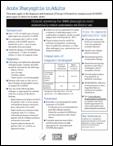
|
Acute Pharyngitis in Adults: Physician Information Sheet (Adults)
Target Audience: Clinicians, Health Educators, Infection Control Professionals, Nurse Practitioners, Nurses, Physician Assistants, Physicians, Pharmacists
Principles apply to the diagnosis and treatment of Group A ß-hemolytic streptococcal (GABHS) pharyngitis in otherwise healthy adults.
|
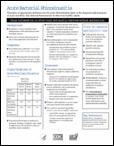
|
Acute Bacterial Rhinosinusitis: Physician Information Sheet (Adults)
Target Audience: Clinicians, Health Educators, Infection Control Professionals, Nurse Practitioners, Nurses, Physician Assistants, Physicians, Pharmacists
Principles of appropriate antibiotic use for acute rhinosinusitis apply to the diagnosis and treatment of acute maxillary and ethmoid rhinosinusitis in otherwise healthy adults.
|
|
Acute Cough Illness (Acute Bronchitis): Physician Information Sheet (Adults)
Target Audience: Clinicians, Health Educators, Infection Control Professionals, Nurse Practitioners, Nurses, Physician Assistants, Physicians, Pharmacists
Principles of appropriate antibiotic use apply to the diagnosis and treatment of uncomplicated acute bronchitis in otherwise healthy adults.
|
Back to top
| Pediatric treatment guidelines for upper respiratory tract infections |
Publications - Principles for Pediatric Appropriate Antibiotic Use
- Principles of Judicious Use of Antimicrobial Agents for Pediatric Upper Respiratory Tract Infections
Dowell SF, Marcy SM, Phillips WR, Gerber MA, Schwartz, B. Pediatrics. 1998;101:163-165.
The guidelines in this article provide evidence-based principles focused on situations in which antimicrobial therapy could be curtailed without compromising patient care. The paper addresses five common upper respiratory infections that account for the majority of outpatient antimicrobial use: otitis media, sinusitis, bronchitis, pharyngitis, and nonspecific upper respiratory tract infection.
Abstract | Full Text
- Diagnosis and Management of Cough: ACCP Evidence-Based Clinical Practice Guidelines
Irwin RS, Baumann MH, Bolser DC, et al: Diagnosis and management of cough: ACCP evidence-based clinical practice guidelines. Chest 1S-292S, 2006.
These practice guidelines (1) more narrowly focuses the guidelines on the diagnosis and treatment of cough, the symptom, in adult and pediatric populations, and minimizes the discussion of cough as a defense mechanism; (2) improves on the rigor of the evidence-based review and describes the methodology in a separate section; (3) updates and expands, when appropriate, all previous sections; and (4) adds new sections with topics that were not previously covered.
Cough Guidelines on the Chest website (exit site)
- Diagnosis and Management of Otitis Media with Effusion
American Academy of Family Physicians, American Academy of Otolaryngology-Head and Neck Surgery, and American Academy of Pediatrics Subcommittee on Otitis Media With Effusion: Otitis media with effusion. Pediatrics 113:1412-1429, 2004.
The purpose of this guideline is to inform clinicians of evidence-based methods to identify, monitor, and manage Otitis Media with Effusion (OME) in children aged 2 months through 12 years.
OME Guidelines on the Pediatrics website (exit site)
Diagnosis and Management of Acute Otitis Media
Subcommittee on Management of Acute Otitis Media: Diagnosis and management of acute otitis media. Pediatrics 113:1451-1465, 2004.
This evidence-based clinical practice guideline provides recommendations to primary care clinicians for the management of children from 2 months through 12 years of age with uncomplicated Acute Otitis Media (AOM).
AOM Guidelines on the AAFP website (exit site)
- Pharyngitis--Principles of Judicious Use of Antimicrobial Agents
Schwartz B, Marcy SM, Phillips WR, Gerber MA, Dowell SF. Pediatrics. 1998;101:171-174.
Clinical findings cannot reliably differentiate streptococcal from viral pharyngitis. Many physicians overestimate the probability of a bacterial infection based on history and physical examination alone. Diagnosis of pharyngitis should be based on results of a throat culture or antigen-detection test with throat culture as a back-up. Accurate diagnosis of group A streptococcal pharyngitis and choosing appropriate antimicrobial therapy are important, particularly to prevent nosuppurative sequelae such as rheumatic fever.
Abstract | Full Text
- Acute Sinusitis--Principles of Judicious Use of Antimicrobial Agents
O'Brien KL, Dowell SF, Schwartz B, Marcy SM, Phillips WR, Gerber , MA . Pediatrics. 1998;101:174-177.
This article outlines the strict criteria for clinical diagnosis of sinusitis. An accurate diagnosis is difficult, but critical because viral sinusitis is 20 to 200 times more common than bacterial infection of the sinuses.
Abstract | Full Text
- Cough Illness/Bronchitis--Principles of Judicious Use of Antimicrobial Agents
O'Brien KL, Dowell SF, Schwartz B, Marcy SM, Phillips WR, Gerber , MA . Pediatrics. 1998;101:178-181.
Millions of courses of antibiotics are prescribed for children with acute cough illness each year, despite evidence that it is not effective. Evidence for the treatment guidelines recommended for cough illness/ bronchitis are presented.
Abstract | Full Text
- The Common Cold--Principles of Judicious Use of Antimicrobial Agents.
Rosenstein N, Phillips WR, Gerber MA, Marcy SM, Schwartz B, Dowell SF. Pediatrics. 1998;101:181-184.
Unnecessary antimicrobial therapy for the common cold can be avoided by recognizing the symptoms that are part of the usual course of the illness. Controlled trial evidence is reviewed and presented to support the recommendations made in this paper.
Abstract | Full Text
Back to top
| One page pediatric academic detailing sheets |
These sheets are useful for conducting small group or one-on-one educational sessions. They have been used by many programs around the country seeking to change clinician prescribing behavior.
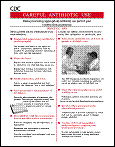
|
Practice Tips:
Physician Information Sheet (Pediatrics)
(Target Audience: Clinicians, Health Educators, Infection Control Professionals, Nurse Practitioners, Nurses, Physician Assistants, Physicians, Pharmacists)
Provides useful messages explaining the growing threat of antibiotic resistance and alternative treatment methods.
|
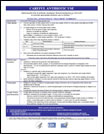
|
Appropriate Treatment Summary:
Physician Information Sheet (Pediatrics)
UPDATED AUGUST 6, 2007
|
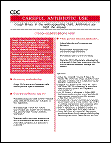
|
Cough Illness/Bronchitis:
Physician Information Sheet (Pediatrics)
(Target Audience: Clinicians, Health Educators, Infection Control Professionals, Nurse Practitioners, Nurses, Physician Assistants, Physicians, Pharmacists)
Provides key information on the treatment of bronchitis and other cold illnesses.
|
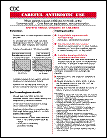
|
The Common Cold: Rhinitis Vs. Sinusitis:
Physician Information Sheet (Pediatrics)
(Target Audience: Clinicians, Health Educators, Infection Control Professionals, Nurse Practitioners, Nurses, Physician Assistants, Physicians, Pharmacists)
When parents request antibiotics for rhinitis or the common cold, give them an explanation not a prescription. Provides information on treatment methods for common cold symptoms.
|
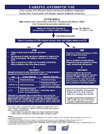
|
Otitis Media:
Physician Information Sheet (Pediatrics)
(Target Audience: Clinicians, Health Educators, Infection Control Professionals, Nurse Practitioners, Nurses, Physician Assistants, Physicians, Pharmacists)
Provides information on differentiating acute otitis media from otitis media with effusion.
|
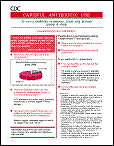
|
Pharyngitis:
Treat Only Proven GAS: Physician Information Sheet (Pediatrics)
(Target Audience: Clinicians, Health Educators, Infection Control Professionals, Nurse Practitioners, Nurses, Physician Assistants, Physicians, Pharmacists)
Provides medical data on viral vs. bacterial throat infections in children and the clinical procedures for distinguishing between each.
|
Back to top
| Materials to use with your patients |
One of the initial activities of CDC's Get Smart campaign was the development and distribution of principles for appropriate antibiotic use for pediatric upper respiratory tract infections. These guidelines were developed in collaboration with the American Academy of Pediatrics and members of the American Academy of Family Physicians. CDC then collaborated with members of the American Academy of Family Physicians, American College of Physicians, Infectious Disease Society of America, and the America College of Emergency Physicians to develop principles of appropriate antibiotic use for adult respiratory tract infections. The pediatric and adult guidelines provide a definition of appropriate prescribing and have been distributed to numerous state and local health departments, health plans, physician groups, and others.
CDC has also produced a series of health education and behavioral change materials for both patients and providers to promote appropriate antibiotic use. These include brochures, posters, question and answer fact sheets for parents on runny nose and otitis media, a day care letter, and a viral prescription pad. The prescription pad in particular has been extremely popular and useful as a communication tool. Healthcare providers can use this tool to recommend strategies for symptomatic relief of viral illnesses, thereby acknowledging the patient's discomfort and suggesting solutions without prescribing an antibiotic unnecessarily.
Materials can be ordered in small quantities through CDC INFO http://wwwn.cdc.gov/pubs/GETSMART.aspx
- Materials can be ordered in bulk from the Public Health Foundation (exit site). Please allow 3-4 weeks for delivery.
- All print materials found on the Get Smart website may be downloaded, copied, and distributed without alteration free of charge.
Video: |
 |
Talking with Patients About Antibiotic Use: An Interaction Model
(Target Audience: Healthy adults ages 18-49 years)
This video displays a conversation between a healthcare provider and a patient. The physician explains to the patient the difference between bacteria and virus and why colds are not treated with antibiotics.
This video was produced in partnership with
Kaiser Permanente
and is available for download only
(cannot be ordered)
All rights reserved, including broadcast of any kind, copying, or reproduction of this material in violation of copyright laws. If you do not have RealPlayer, you can obtain it free from the RealNetworks website (exit site).
 |
Back to top
Surveillance Systems: The ongoing systematic collection and analysis of data. The data may lead to actions taken to prevent and control an infectious disease.
Active Bacterial Core surveillance (ABCs)
Active Bacterial Core surveillance (ABCs) is a core component of CDC's Emerging Infections Programs Network ( EIP), a collaboration between CDC, state health departments, and universities. ABCs is an active laboratory- and population-based surveillance system for invasive bacterial pathogens of public health importance. For each case of invasive disease in the surveillance population, a case report with basic demographic information is completed and bacterial isolates are sent to CDC and other reference laboratories for additional laboratory evaluation, including drug resistance profiling.
ABCs data have been used to track disease trends, including the decline in pneumococcal disease following the introduction of the pediatric pneumococcal conjugate vaccine. A program to assist state and local health departments with surveillance for MRSA and drug-resistant Streptococcus pneumoniae has been developed, based primarily on lessons learned from ABCs.
ABCs reports and findings
ABCs brochure  PDF 155KB (text-only) PDF 155KB (text-only)
Additional surveillance resources
Back to top
| Quick links for healthcare providers |
Back to top |